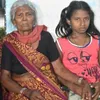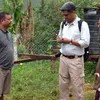This international NGO has been rescuing and rehabilitating bonded labourers in India
International Justice Mission aims to protect and deliver justice to millions of poor people by working alongside government officials and grassroot-level organisations.
Chandramma looks at a silk saree very differently from the way any privileged Indian does. This exquisite fabric is a reminder of her lifetime of struggle and hardship. Now 32, she lives with the dark memory of a time when freedom was far-fetched.
Pulled out from her basic education when she was barely eight years old, Chandramma was taught how to hold the thread and how it was to be rolled and twisted. Coming from a poor background, she found herself in many torturous bonded labour conditions due to her desperate need for money, especially in sericulture units.

Chandramma - a victim of bonded labour
Like Chandramma, many people with a background of poverty get trapped into bonded labour and human trafficking, with tempting monetary deals for longer periods of work. But the truth is, the amount promised is not justified, and freedom is severely compromised.
Founded in 1997, International Justice Mission (IJM) is a global organisation that collaborates with the State and Central Governments to protect the poor from violent forms of injustice, including bonded labour and sex trafficking in India by assisting the public justice system.
IJM’s social workers and contract advocates partner with the local District Administration, Police and Public Prosecutors across states to ensure victim rescue, rehabilitation, capacity building and prosecution of perpetrators.
In a conversation with Social Story, Indrajeet Pawar, Director of Operations, and Prathima M., Associate Director, of IJM Bengaluru, talk about how the team has been working to bring justice to these victims.
Bonded labour system
“There are two specific kinds of human trafficking that we work with – sex trafficking, especially of minors, and bonded labour,” explains Indrajeet. “In Karnataka, our team works for the rescue of bonded labourers,” he adds.
In a bonded labour system, people are given an amount of money for a certain duration varying from a few months to many decades. The average advance would range between Rs 25,000 to Rs 30,000 but can even be as low as Rs 1,000.

Bonded labourers at the quarry, with the inspector and Tahsildar
False promises like good food, good housing, good wages, etc., are made, but after the labourers arrive at the factory, the advance is used to restrict their freedom. Heavy interest rates are imposed on the advance amount which they cannot repay if they want to return.
“Brick kilns, rock quarries, and stone crushers are some of the areas we found people trapped in bonded labour,” says Prathima. “However, the crime has been evolving and we’ve worked with the government to rescue people from the plastic recycling units, sericulture industries, agriculture industries, sand mining industry and the manufacturing industries, but our work isn’t limited to these industries.”
According a study conducted by IJM, the Bitti Chakri labour practice is becoming prominent in North Karnataka. Under this system, the labourers are from the ‘backward castes’ and are unpaid, unlike the bonded labour system. It becomes a customary obligation for the labourer to send a family member in his or her absence.
The team is urging the government to bring this practice under the Bonded Labour System Act, 1976, where it is listed as illegal.
In the last 15 years of rescue operations, IJM has found out that most of the victims are young adults in the age group of 25 to 30 years -- 58 percent of rescued labourers are male while 42 percent are female, 38 percent of victims are children and minors below the age of 18 who were working along with their parents, on their own or were younger children who were not working but were trapped in the same conditions with their parents.
Rescue operations
“Our first rescue operation was in 2005, at a brick kiln in Bengaluru South, along with the ACP of the Bengaluru South Division,” says Prathima. “There were nine people of a family who came from Krishnagiri and received a meagre advance for a period of two years and worked for about 13 hours a day.”
The victims would get ‘market days’ if they worked for six days a week, where they could go and buy essentials, including food supplies. If not, they would get about Rs 400, of which Rs 200 would get deducted towards their advance.
As part of the rescue operations, the team approaches the District Legal Services Authority, which initiates the rescue process. The process not only involves the rescue of victims, but also bringing the employer to book.

Rescued victims led out by the policemen.
To achieve both the objectives, the team involves different departments – the District Administration, which is the implementing authority under the Bonded Labour Abolition Act (BLA), the Labour Department as these daily wagers do not receive their basic wages, the Police Department for safety, security and if an FIR needs to be registered, and the Department of Women and Child Development in case there are children at the factories.
The team at IJM coordinates with these departments and makes a visit to the site. A small enquiry is conducted to ascertain the elements of bonded labour present in the condition.
“During our rescue operation at a brick kiln in 2020, we asked the labourers about their condition, but they refused to speak pointing towards a man, and stating that his presence made them uncomfortable,” says Prathima. “The police department immediately arrested the man,” she adds.
Once the government officials understand the gravity of the situation, the labourers are taken to a place where a detailed enquiry is conducted according to the procedures laid down by the Centre Sector Scheme (CSS), from the Ministry of Labour and Employment (MoLE).
Based on the severity of the crime, reports are made and submitted to the district magistrate, who releases them officially. At the same time, a release certificate is given to the victims, which serves as an ID card and a document is issued that gives them access to government benefits. It also mentions that they will not be obligated to repay the employer.
“Though the plan seems well laid out and simple, there lies a challenge to bring together all the departments for the operation,” says Indrajeet. “However, it has become easier than what it was 10 years ago. We have also been trying to form a standard operating procedure to make things simpler.”
New lease of life
IJM in India, along with some partner organisations it works with, has assisted the governments in different states to rescue over 20,000 victims of bonded labour since 2001.
One of the rescued victims, Madesh was appointed for a job in Bengaluru-based Biospace Technologies in the heart of the city. Today, despite the nationwide restrictions, he continues to work to help the needy. This comes after 24 years of lockdown for Madesh.
Madesh and his family had been working and living as bonded labourers at a rock quarry in Jigani for upto 24 years. They were rescued in December 2017 by the Bangalore Urban District Administration, local police and Labour Department with IJM’s assistance.

Madesh - (L) In grey, during the rescue operation, (R) outside his office in Bengaluru
“More than anything else, I am happy to be free,” says Madesh. “I never thought I would live to see what lies outside the factory, but here I am today, with a job that can support my family.”
Prior to moving to Bengaluru, Madesh also managed to build a two-room house for his family in Rayakottai on a small piece of land they owned in March 2020. He built it himself with help from family members and fellow villagers.
Chandramma, who had been working in a silk factory, is now a free woman, who is doing a job of her choice. Even though the silk threads and illegal organ transplants have left a scar, she stands strong and wishes to provide a better life for her two sons.

Chandramma, after the rescue
Impact of COVID-19
“We had a number of programmes laid out including three capacity building programmes, which were paused due to the restrictions,” says Indrajeet. “So, this season, we’ve been assisting the Karnataka government in distributing ration and other essentials to the vulnerable sections besides running campaigns on COVID-19,” he adds.
With the lockdown in place, many employers released the labourers as they were unable to pay them, which again puts them in a spot. In some facilities, they are provided with minimum food.
The IJM team conducted a webinar in association with a team based in Chennai, on an international level. Through these webinars and discussions, it aims to understand the effects of the rescue operations post-lockdown.
“We are also looking at the changes in our future operations with the new normal in place,” Indrajeet contemplates. “Our hope is that we get back to some semblance of normalcy and are able to engage with the government for our future operations,” he says.
Edited by Javed Gaihlot










